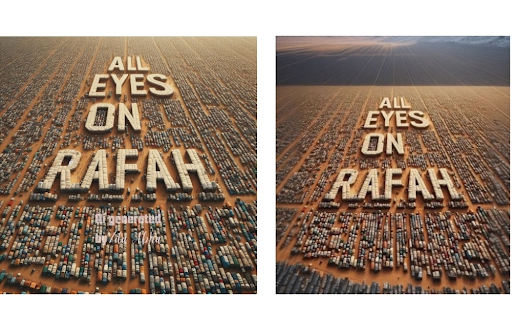
- Viral Impact: An AI-generated image depicting a scene resembling a camp in Rafah, Gaza, gained immense popularity, shared by millions on social media, including many celebrities.
- Origin Story: Created by AI hobbyist Zila Abka, the image sparked controversy when another artist, Amiral Shah, claimed it as his own. The debate raised questions about AI art ownership and ethical considerations.
- Future Implications: The incident underscores the evolving landscape of AI art and its authenticity, prompting discussions on legal, ethical, and societal implications as generative AI becomes more prevalent.
The Viral Image: Origins and Impact
The image is hard to miss. A picture of a desert filled with tents, snow-capped mountains in the background, and the text “All eyes on Rafah” superimposed in the tents. This AI-generated image has been posted and shared across Instagram around 50 million times with celebrities such as Dua Lipa, Mark Ruffalo, Lewis Hamilton, Bella Hadid, and more. What’s the fuss all about? Amidst its skyrocketing popularity, two artists are claiming credit as the masterminds behind its viral success.
Origins of the Viral Sensation
The story behind the viral internet sensation likely begins on the Northern tip of the Southeast Asian island of Borneo. Back in February, an AI hobbyist, Zila Abka, was at home using Microsoft’s AI tool image creator. She wanted to make a political piece of art that depicted those sheltering in camps in the Gazan city of Rafah after the phrase “All eyes on Rafah” had started going viral after a deadly incident in Rafah led to people posting clips of Richard Peeperkorn, a representative of the World Health Organization in the occupied Palestinian territories, speaking in February. He told journalists at the time that “All eyes are on Rafah”, warning against Israeli forces attacking the city.
After Akba had generated and put watermarks on the graphic stating it was AI art and she was the creator, she swiftly decided to share a post on Feb. 14, to the Facebook group Prompters Malaya, a gathering place of Malaysians who post AI-Generated art, sometimes about the war in Gaza. After posting to the Facebook group, Akba had forgotten all about her post, until last week when a very similar image started appearing around social media, spreading quickly after an Israeli strike in the city that killed dozens and caused worldwide condemnation. But the image wasn’t hers. The watermarks were gone, and the image had been expanded to show snow-capped mountains in the distance. She zoomed in and thoroughly examined every corner, letter, and detail of the viral sensation, and she concluded that it had to be hers.
Legal and Ethical Considerations
However, Akba’s frustration and annoyance for not getting credit quickly dissipated. “I don’t think any generated AI image is fully someone’s belonging,” Abka said, and the U.S. Copyright office shares a similar idea. The Copyright office has repeatedly rejected copyright protection for AI-generated images since they lack human authorship, placing AI images in a legal gray area. It was Akba’s unique prompt that generated the image, and she thinks that should be worth something. However, getting support for Gaza was always her main purpose and “If the aim is to spread awareness,” Abka said about the version of the image that went viral, “then I think I should thank that person.” But who is the person that should be thanked?
The Alleged Plagiarism
Amiral Shah, better known as ‘Shahv4012’ on Instagram, is the person who Akba believes stole her cropped and edited it with another AI tool made to expand and re-imagine the original material. She believes this because she had supposedly tried it herself and found it had gotten very similar results to the viral image. Shah’s image has his own watermark on it, including the tag of his photography Instagram account, @chaa.my_, giving the impression that the whole thing was his original doing. Shah denies copying Akba’s creation and says he was toying around with AI art generators. He thinks he was using Microsoft’s image creator, the same generator Akba was using, but Shah says he can’t remember.
The image looks very similar to Abka’s, but he claims he had never even seen Abka’s before making his own. Still, the size of the word placement of each letter and AI-generated tents next to the phrase are identical. But Shah’s version is from a higher view, with deeper and longer shadows cast by snowy mountains. According to an NPR article, Shah says, “My intention was not for popularity, I wanted to uphold justice for all Palestinians who are there”. Shah, who frequently posts on social media highlighting Palestinians, said he has noticed that real photos and videos of the War tend to have a limited reach on Instagram. “Pictures from AI can spread faster,” says Shah. The “All eyes on Rafah” image does not show a real place or the actual City of Rafah, Notably absent are graphic pictures of dead bodies, blood, shots of real people, names, or distressing scenes.
The Future of AI Art and its Authenticity
With all the conflict between AI art originality and the virality of AI art, it leads to the question: what will the Landscape of AI art and its authenticity look like in the future? Generative AI is becoming more prevalent in creative industries all across the world and will continue to do so. However, legal implications of using generative AI are still unclear, particularly in relation to copyright infringement, ownership of AI-generated works, and unlicensed content in training data. Courts are currently trying to establish how intellectual property laws should be applied to generative AI. There is virtually no major industry that AI has not or will affect. AI is growing at a rapid pace and it will only continue to grow, it’s now in our hands to see how this will resonate and affect our everyday lives.
